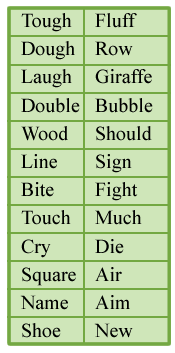|
Audience: Beginning to low-intermediate ESL or EFL students
Using poetry in a language class does not necessarily mean incorporating poems that have a deep philosophical implication or abstract concepts. Even simple rhymed verses can make a difference in your class by fostering learning with more interactive, lively, and enjoyable activities. Here are three ideas to help you get started.
Practicing Pronunciation
To practice pronunciation of English vowels, you can use short rhymed riddles.
Step 1
Prepare several rhymed riddles where the rhyming words would have a target vowel or a diphthong. Here are some examples:
I bring you warmth, I bring you fun.
I am bright and shiny. I am the SUN.
You’ll need a recipe to make
A sweet and yummy chocolate CAKE.
This is a word that rhymes with hat.
I purr and meow, I am a CAT.
This is a word that rhymes with silk.
I am white, I am liquid, I am MILK.
I bring much happiness and joy.
All children like me. I am a TOY.
I am in the dark sky very far.
I am a sparkling little STAR.
Step 2
Display a riddle on a PowerPoint slide (or use a projector, or simply give the students a worksheet) with the final word of the second verse missing:
Examples:
You’ll need a recipe to make
A sweet and yummy chocolate _________.
I bring much happiness and joy.
All children like me. I am a ___________.
Step 3
Ask one student to read the riddle aloud and finish it with the missing word.
Options
If you have more advanced students, you can give each student (or a pair of students) two rhymed words and ask them to create their own riddle for their classmates. Alternatively, you can make it a team competition. Either way, it’s fun, interactive, and creative.
Making Grammar Fun
Grammar exercises don’t need to be dry and boring. You can make a use of rhymes to practice different grammar principles. For example, to have students practice simple past tense, you can give them a few verbs (e.g., to make, to drive, to buy, to watch) and ask them to write simple rhymed verses about what they did the day before/last weekend/last week using past tense forms. Try to include both regular and irregular verbs.
Example (using the verbs to eat, to like, to be):
Last week I ate a cherry cream puff.
I didn’t like it; it was tough.
Options
You can adjust this activity to practice other verb tenses (e.g., present progressive, future).
Fostering Group Work and Interaction
Because writing rhymes is a creative activity, you can use it to enhance student interaction.
Step 1
Prepare a list of rhymed words—about 12–15 pairs. Try to come up with words that rhyme but have different spelling rules.
Examples:

Step 2
Using the words from the first column, prepare cards (with one word written on each card). Write the words from the second column on the board.
Step 3
Ask a student to pick a card, read the word aloud, and find a rhyme for this word from the ones listed on the board.
Step 4
Divide the class into teams and, using the selected word pair, ask each team to create a simple (2-line long) rhymed verse. One person from each team will write the rhyme on the board. The class will decide whose rhyme is the best. You may want to prepare a few simple rubrics for how students should judge verses—or let students come up with their own rubrics prior to the activity.
Step 5
Repeat the activity for the rest of the words you prepared.
Variations
- To make this activity more lively and fun, you can put a time limit on Step 5. There is also much laughter involved in this activity.
- For more advanced students, add more requirements to the verses they come up with: the use of specific tenses, vocabulary words, or themes.
Conclusion
Using rhymed verses does not only allow you to make teaching more fun and interactive, but it also gives students a chance to creatively use their language knowledge. I hope these simple ideas will be helpful to you, and I hope they will lead you in new directions.
___________________
Elena Shvidko is a PhD student in the Department of English at Purdue University. Her academic interests include second language acquisition, second language writing, and writing program administration.
|